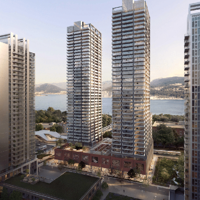Moody Centre Tower Height Dispute: Council Rejects Referendum Amidst Community Division
The City of Port Moody has become a battleground over development, specifically concerning the height of proposed towers in the Moody Centre transit-oriented area (TOA). A recent council meeting saw a 6-1 vote against holding a referendum on the issue, despite considerable public support for such a measure. The decision sparked heated debate, highlighting deep divisions within the community regarding the future of the neighbourhood. At the heart of the controversy lies the recently adopted Moody Centre TOA framework, which increased the allowable tower height from 26 to 40 storeys. This change, envisioned to accommodate up to 14 towers in a 23-acre area north of St. Johns Street, has been met with resistance from some residents who feel their voices have not been adequately heard.
Council members who opposed the referendum argued that it would be a flawed process, susceptible to misinformation and manipulation. They pointed to the contentious online discussions and conflicting public opinions as evidence of a divided community, suggesting that a referendum would only exacerbate the existing tensions. Instead, they emphasized the importance of council’s elected role in making informed decisions, suggesting that the next municipal election should serve as the true referendum on the issue. Mayor Meghan Lahti echoed this sentiment, stating, "We were elected to make decisions, and in my opinion, the next election is the referendum.” This perspective underscores the council’s belief in their mandate to act on behalf of the entire community, rather than relying on a potentially skewed public vote.
Councillor Haven Lurbiecki, the sole proponent of the referendum, argued that the TOA framework was implemented without sufficient community engagement and contradicts previous survey results indicating resident opposition to even 26-storey buildings. Lurbiecki also highlighted a perceived decline in community satisfaction and public input regarding council decisions. She urged the council to "put this issue to rest once and for all" and allow residents a direct voice in shaping the future of their neighbourhood. Lurbiecki’s stance reflects the concerns of a significant portion of the community who feel unheard and marginalized in the development process. The clashing viewpoints underscore a fundamental disagreement on how best to gauge and respond to public opinion in the face of complex urban planning decisions.
The proposed referendum aimed to gauge support for the 40-storey height limit and would have temporarily halted further development in Moody Centre until the results were published. This aspect of the proposal drew criticism from some council members, who questioned its legality and the council’s obligation to consider all development applications. Mayor Lahti questioned the motives behind the referendum proposal, suggesting it was a deliberate attempt to create division and paint the council as unresponsive to community concerns. This accusation further fuels the already heated debate and highlights the deep mistrust that exists between some residents and the council.
Council members opposing the referendum also raised concerns about the spread of misinformation on social media, which they believe has significantly influenced public opinion. While few specific examples were provided, the council expressed concern about the potential for "bad actors" to manipulate public discourse and undermine faith in the decision-making process. This concern, while understandable, also risks dismissing legitimate concerns about development as mere products of misinformation, potentially further alienating those who feel their voices are being ignored. The challenge lies in balancing the need to address misinformation with the equally important task of ensuring genuine public engagement and transparency.
The debate over tower height in Moody Centre reflects a broader struggle between the imperative for densification in rapidly growing urban areas and the desire to preserve the character and livability of existing neighbourhoods. Council members advocating for taller buildings emphasize the need for increased housing density, particularly in transit-oriented areas, to accommodate the growing population and address affordability challenges. They also point to the potential for significant community benefits, such as new amenities and infrastructure improvements, that can be secured through these developments. Opponents, however, express concerns about the potential negative impacts of high-density development on traffic, parking, green space, and the overall quality of life in the community. The Moody Centre case highlights the complex trade-offs inherent in urban planning decisions and the difficulty of balancing competing interests and values. Finding a path forward requires open and honest dialogue, a commitment to transparency, and a willingness to engage with all stakeholders to find common ground. The future of Moody Centre hinges on the ability of the council and the community to bridge the divide and work together to create a shared vision for the neighbourhood.


